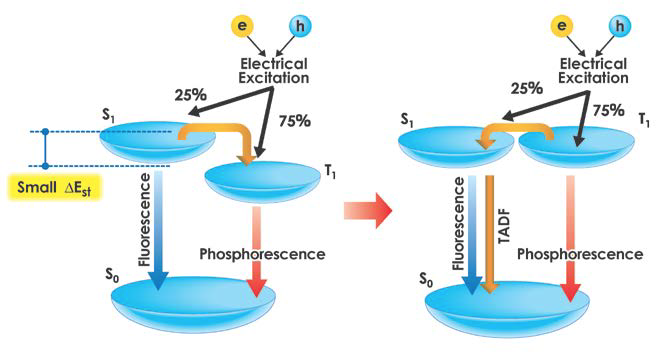

Nearly 100% electron-photon conversion by using novel strategy of harvesting triplet excitons in organic light emitting devices
安達 千波矢 教授
(九州大学 最先端有機光エレクトロニクス研究センター 教授)
2015年2月6日(金) 16:00-17:00
AIMR本館2階 セミナー室
Organic light emitting diodes (OLEDs) have been anticipated to exhibit highly efficient, stable emission aimed for displays and lighting applications. Here, we report the design rules for increasing the electroluminescence efficiency based on thermally activated delayed fluorescence (TADF). We show that a large delocalization of the highest occupied molecular orbital and lowest unoccupied molecular orbital in these charge transfer compounds enhances the rate of radiative decay considerably by inducing a large oscillator strength even when there is a small overlap between the two wavefunctions. Further, through computational simulation, we identified intramolecular charge-transfer (CT) molecules with small singlet-triplet CT state splitting but different energy relationships between 3CT and locally-excited triplet (3LE) states. Systematic comparison of excited-state dynamics revealed that CT molecules can emit efficient and short-lifetime (a few μs) TADF when the emission peak energy is high enough and the 3LE state is higher than the 3CT state. The OLEDs with TADF emitters offer an external quantum efficiency over 20% and reduced efficiency roll-off characteristics at high luminance. Also, we mention the importance of molecular orientation for enhancing light outcoupling efficiency. Some critical molecular design and processing condition will be discussed. Further, we report fluorescence-based OLEDs that realize external quantum efficiencies as high as 20% for blue, green, yellow, and red emission, indicating that the exciton production efficiency reached nearly 100%. The high performance was enabled by utilization of TADF molecules as assistant dopants that permit efficient transfer of all electrically generated singlet and triplet excitons from the assistant dopants to the fluorescent emitters. OLEDs employing this novel exciton harvesting process provide freedom for the selection of emitters from a wide variety of conventional fluorescent molecules.
[1] A. Endo, M. Ogasawara, A. Takahashi, D. Yokoyama, Y. Kato, C. Adachi, Adv. Mater., 21, 4802 (2009)
[2] K. Goushi, K. Yoshida, K. Sato, C. Adachi, Nat. Photon., 6, 253 (2012)
[3] H. Uoyama, K. Goushi, K. Shizu, H. Nomura, C. Adachi, Nature, 492, 234 (2012)
[4] Q. Zhang, B. Li, S. Huang, H. Nomura, H. Tanaka, C. Adachi, Nat. Photonics., 8, 326 (2014)
[5] H. Nakanotani, T. Higuchi, T. Furukawa, K. Masui, K. Morimoto, M. Numata, H. Tanaka, Y. Sagara, T. Yasuda, C. Adachi, Nat. Commun., 5, 4016 (2014)
 Energy diagram of typical organic molecule and concept of TADF.
Energy diagram of typical organic molecule and concept of TADF.
AIMR事務部門 総務係
| TEL : | 022-217-5922 |
|---|---|
| E-MAIL : | wpi-soumu@wpi-aimr.tohoku.ac.jp |